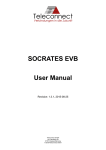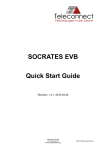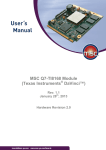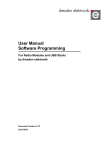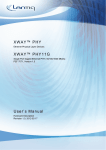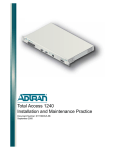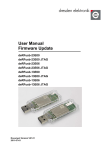Download User Manual - Teleconnect
Transcript
SOCRATES EVB User Manual Revision: 1.2.2, 2015-04-27 Teleconnect GmbH Am Lehmberg 54 01157 Dresden/Germany © 2015Teleconnect GmbH SOCRATES EVB User Manual Revision History: Current Revision: 1.2.2, 2015-04-27 Revision 1.0.0 1.2.1 1.2.2 Revision: 1.2.2, 2015-04-21 Date 1-Feb-15 20-Apr-15 27-Apr-15 Comment Initial revision for software release 1.0 Update to software release 1.2 Minor changes 2/24 [email protected] SOCRATES EVB User Manual Table of Contents 1 2 3 4 Introduction .................................................................................................................... 5 1.1 Scope of Document ................................................................................................. 5 1.2 General Introduction ................................................................................................ 5 1.3 Content of the SOCRATES EVB Reference Board Kit ............................................ 6 Block Diagram ................................................................................................................ 7 Interfaces ....................................................................................................................... 8 3.1 Design Overview ..................................................................................................... 8 3.2 SHDSL Interface ..................................................................................................... 8 3.3 Ethernet Interface.................................................................................................... 9 3.4 Power Supply Input ................................................................................................10 3.5 Serial Interface (UART) ..........................................................................................11 3.6 Debug interface ......................................................................................................11 3.7 Control and Monitoring Interface ............................................................................12 3.7.1 Buttons ............................................................................................................12 3.7.2 DIP switches ...................................................................................................12 3.7.3 Rotary switch ..................................................................................................13 3.7.4 LEDs ...............................................................................................................14 Software ........................................................................................................................15 4.1 Updating Firmware .................................................................................................15 4.1.1 Preparation .....................................................................................................15 4.1.2 Using the in-system programmer ....................................................................15 4.2 SOCRATES EVB Firmware....................................................................................17 4.3 User Interface.........................................................................................................17 5 Operation ......................................................................................................................19 5.1 Start-up with two Boards ........................................................................................19 6 Using SOCRATES EVB as Module ...............................................................................20 6.1 Scope .....................................................................................................................20 7 8 6.2 Connection .............................................................................................................20 6.3 Protection ...............................................................................................................21 BoM of SOCRATES EVB ..............................................................................................22 Literature .......................................................................................................................24 Revision: 1.2.2, 2015-04-21 3/24 [email protected] SOCRATES EVB User Manual List of Figures Figure 1: Structure of SHDSL Connection ............................................................................. 5 Figure 2: SOCRATES EVB Reference Board, V1.0 ............................................................... 6 Figure 3: Block Diagram of the SOCRATES EVB Reference Board V1.0 .............................. 7 Figure 4: Design of the SOCRATES EVB Reference Board V1.0 .......................................... 8 Figure 5: SHDSL Interface .................................................................................................... 8 Figure 6: Schematic of SHDSL Hybrid ................................................................................... 9 Figure 7: Ethernet interface ................................................................................................... 9 Figure 8: Pin Definition of X202 ............................................................................................10 Figure 9: Schematic of Ethernet Interface ............................................................................10 Figure 10: Position of Connectors ........................................................................................21 Revision: 1.2.2, 2015-04-21 4/24 [email protected] SOCRATES EVB User Manual 1 Introduction 1.1 Scope of Document This document describes the hardware and software to get started with the SOCRATES EVB V1.0 Reference Board. For a short introduction of the SOCRATES EVB V1.0 Reference Board you can use the “SOCRATES EVB Quick Start Guide”, also provided by Teleconnect. The actual implemented software features are defined in the “SOCRATES EVB Firmware Release Note”. This document will be updated with each new firmware version. Teleconnect (http://www.teleconnect.de/xdsl/socrates-evb) provides all necessary documentations for recreating the hardware. This includes schematic, components layout placement, board outline, PCB layout and bill of materials. Further the Gerber files are also available but you get it only upon request. 1.2 General Introduction The new SOCRATES EVB 1.0 reference design targeting industrial designs enables new customers to take advantage of Lantiq SHDSL for long reach broadband connectivity. It is the first ever ready-to-copy reference design developed for the Lantiq SOCRATES chip. The SHDSL/Ethernet Bridge Modem was developed by Teleconnect and measures only about 9 x 5 cm and is available for online purchase through the Würth Midcom Website (http://www.we-online.com/socratesdemo). Teleconnect offers dedicated support for board and software customizations. With this, for the first time ever even smaller companies without DSL expertise can include SHDSL and Long-Reach-Ethernet connectivity into their designs. SHDSL’s unique rate/reach performance makes it the product of choice in an ever more diversified field of applications ranging from business broadband access to enterprise networks and industrial communications. Known as long haul Ethernet, SHDSL was included in the Ethernet standard IEEE 802.32008 [3], where it is named 2BASE-TL. Standard Ethernet has a maximum reach of 100 m. SHDSL has a reach beyond 15 kilometres. Using SHDSL makes it possible to transmit Ethernet over only one unshielded twisted wire pair or over any other cable. The general structure of SHDSL is shown at Figure 1. Figure 1: Structure of SHDSL Connection Revision: 1.2.2, 2015-04-21 5/24 [email protected] SOCRATES EVB User Manual 1.3 Content of the SOCRATES EVB Reference Board Kit The reference kit contains the SOCRATES EVB Reference Board V1.0 shown in Figure 2. Beside this you need a power source provided via micro USB cable. For Ethernet and SHDSL connection, standard Ethernet patch cables can be used. Figure 2: SOCRATES EVB Reference Board, V1.0 Revision: 1.2.2, 2015-04-21 6/24 [email protected] SOCRATES EVB User Manual 2 Block Diagram Figure 3 shows the block diagram of the SOCRATES EVB Reference Board. Figure 3: Block Diagram of the SOCRATES EVB Reference Board V1.0 The SOCRATES EVB Reference Board consists of the following blocks: SHDSL transceiver Lantiq SOCRATES-1E (PEF 21628) V1.2. The functionality of the Evaluation Board could be realized also with the 2ch or 4ch versions of the SOCRATES-xE (PEF 22628 and PEF 24628). In any case only one channel is used. Ethernet PHY Lantiq XWAY PHY11G (PEF 7072), Version 1.5. The PHY11G is a Gigabit Ethernet PHY. However, in this application only 10/100BaseTX is available. Microcontroller Atmel ATSAM4SA16. The microcontroller is used for configuration, controlling and monitoring. The requirements of the microcontroller are very low, e.g. an 8 bit controller has enough performance for SHDSL. We use the ARM based microcontroller for a high flexible evaluation platform. RJ45 connectors (shielded for Ethernet and unshielded for SHDSL), both from Würth Elektronik eiSos GmbH Micro USB connector Type B (Würth Elektronik eiSos GmbH) SHDSL Hybrid including SHDSL transformer (Würth Midcom) Ethernet magnetics (Würth Elektronik eiSos GmbH) DC/DC converter from 5 V to 3.3 V, 1.5 V and 1.0 V. Three voltage regulators from MPS (Mini-Module Family) are used. XTAL for SHDSL-transceiver, Ethernet-PHY and Microcontroller (Geyer Quarz) Input and Output components (Würth Elektronik eiSos GmbH): o Rotary switch o DIP switches o Push buttons o ISP pin header for debugging of the microcontroller o LEDs Revision: 1.2.2, 2015-04-21 7/24 [email protected] SOCRATES EVB User Manual 3 Interfaces This chapter describes the interfaces and header pinouts of the SOCRATES EVB Reference Board, V1.0. 3.1 Design Overview The design with its main function blocks and important components are shown in Figure 4. The description for it is given in the following section. Figure 4: Design of the SOCRATES EVB Reference Board V1.0 3.2 SHDSL Interface The SHDSL interface is divided in SHDSL connector, SHDSL Transformer, Protection, Hybrid and SHDSL data pump (see Figure 5). Figure 5: SHDSL Interface Additional primary protection is necessary depending on requirements. There is no primary protection on the Socrates EVB available. The connector X102 is an unshielded RJ45 connector. It is used for connecting the SOCRATES EVB to one SHDSL line (according ITU-T G.991.2 [4]). Table 1 shows the pin definition of X102. Table 1: Pin Definition of X102 Pin Number 1…3 4 5 6…8 Revision: 1.2.2, 2015-04-21 Pin Name / Function Not connected SHDSL line - Tip SHDSL line - Ring Not connected 8/24 [email protected] SOCRATES EVB User Manual Typical lines are unshielded twisted pair cables. Any standard Ethernet cable is also usable. Beside the RJ45 connector X102 SOCRATES EVB provides the possibility to use the pin header X101 spaced 2.54 millimetres (0.1 in). Table 2 gives the pin definition. Table 2: Pin Definition of X101 Pin Number 1 2 Pin Name / Function SHDSL line - Tip SHDSL line - Ring The pin header X101 is not mounted by default. It is possible to mount it on both PCB sides to get an easy test adapter for evaluation or to use the SOCRATES EVB as a module. Figure 6 shows the schematic of the SHDSL hybrid with line transformer L101 and SOCRATES data pump V101 (PEF21628E). Figure 6: Schematic of SHDSL Hybrid Components and layout are influencing the SHDSL performance. Teleconnect can assist you with the selection of additional line protection at raw ambient conditions. There are pin compatible 2 and 4 channel SHDSL chips available. These chips are also usable at SOCRATES EVB. However, SOCRATES EVB provides only one SHDSL channel. Please note, depending on serial number your SOCRATES EVB may be mounted SOCRATES-1e or SOCRATES-4e. 3.3 Ethernet Interface The Ethernet interface is divided in connector, transformer (magnetics) and Ethernet PHY (see Figure 7). Figure 7: Ethernet interface The shielded RJ45 connector X201 is a standard Ethernet interface. It is compatible with 10BASE-T and 100BASE-TX Ethernet according to IEEE 802.3 [3] and can be connected to a twisted pair medium such as CAT5 cable infrastructure. Revision: 1.2.2, 2015-04-21 9/24 [email protected] SOCRATES EVB User Manual Beside the RJ45 connector, SOCRATES EVB provides the possibility to use the pin header X202 spaced 2.54 millimetres (0.1 in). Figure 8 and Table 3 give the pin definition. Table 3: Pin Definition of X202 Figure 8: Pin Definition of X202 Pin Number 1 2 3 4 5 6 7 8 Pin Name / Function TX/RX1 + TX/RX1 TX/RX2 + TX/RX2 Not used for 10/100BASE-TX Not used for 10/100BASE-TX Not used for 10/100BASE-TX Not used for 10/100BASE-TX The pin header X202 is not mounted by default. It is possible to mount it on both PCB sides to get an easy test adapter for evaluation or to use the SOCRATES EVB as module (see chapter 6). The transformer L201 connects the connector to the XWAY PHY11G Ethernet PHY V201 (PEF7072). The connection to the SHDSL data pump SOCRATES V101 is given via standard MII interface. Figure 9 shows the schematic of the Ethernet interface. Figure 9: Schematic of Ethernet Interface 3.4 Power Supply Input For the power supply a Micro USB connector Type B with standard pin assignment (according to USB specification) is used. This gives the possibility to use a standard USB plug-in power supply with 5 V output. We recommend using power supply with at least 500 mA output current (which is commonly given). Please note the power consumption of the Revision: 1.2.2, 2015-04-21 10/24 [email protected] SOCRATES EVB User Manual SOCRATES EVB with SOCRATES-4e mounted is higher than versions with SOCRATES-1e mounted. It is also possible to connect the Micro USB connector to any self-powered USB host interface with the standard USB cable. Please note that SOCRATES EVB has no standard USB conform interface because of missing power management. However, commonly it works. Beside the Micro USB connector SOCRATES EVB provides the possibility to use the pin header X601 spaced 2.54 millimetres (0.1 in) for power supply. Table 4 gives the pin definition. Table 4: Pin Definition of X601 Pin Number 1 2 Pin Name / Function + 5 V (4.0 … 6.0 V) - (Ground) The pin header X601 is not mounted by default. It is possible to mount it on both PCB sides getting an adapter or using the SOCRATES EVB as module. The Micro USB connector is also usable for data transmission to the processor. In that case UART emulation gives a serial interface. 3.5 Serial Interface (UART) SOCRATES EVB features a serial interface (UART) for controlling and monitoring proposes. The interface is usable in two ways: UART emulation via USB interface and TTL-compatible interface via connector X401. Both interfaces have the same function and can work simultaneously. The pin header X401, also named “UART”, is not mounted by default. It is possible to mount any 2.54 millimetres (0.1 in) spaced pin header at both sides of the PCB. So the soldering pads are usable as an easy test adapter for evaluation or as a module placed on a host board. Table 5 shows the pin definition of X401. Table 5: Pin Definition of X401 Pin Number 1 2 3 4 Pin Name / Function + 3,3V RX TX Ground 3.6 Debug interface The controlling processor of SOCRATES EVB is Atmel’s ATSAM4SA16. Based on the powerful ARM Cortex-M4 core, the SAM4S series gives improved performance, low power consumption and an easy to use processor. The processor gives much more performance and periphery than SOCRATES needs. This offers a good basis for the development of own software. With the connector X402 (“JTAG”) SOCRATES EVB provides a compatible interface to Atmel’s development and debugging tools. For example the SAM-ICE, Atmel’s JTAG Emulator for ARM core-based microcontrollers is usable. Revision: 1.2.2, 2015-04-21 11/24 [email protected] SOCRATES EVB User Manual X402 is a 2.54 millimetres (0.1 in) spaced pin header. The pin definition is given at Table 6. Table 6: Pin Definition of X202 Pin Number 1 2 3 4 5 6 7 8 9 10 Pin Name / Function TCK Ground TDO + 3.3V TMS Reset (NRST) Not used Not used TDI Ground 3.7 Control and Monitoring Interface SOCRATES EVB provides on board software usable for many standard applications. For configuration and status information, several buttons, switches and LEDs are available. The following section gives more information. 3.7.1 Buttons There are two buttons available. The first is the button S402 called “RESET”. Pressing this button triggers hardware reset of the processor and the SHDSL interface. The software restarts and makes new initialisation of SOCRATES EVB. If any configuration is changed a reset is required. The second button is the button S403 called “ERASE” with two functions. During reset (Reset button is also pressed) the whole flash memory will be cleared. This is necessary to reload a new Firmware version via processor’s SAM-BA interface. During runtime, additional information about software and line state will be printed to serial interfaces (UART and USB) if the button “ERASE” is pressed. Please see Figure 4 for the location of the buttons. 3.7.2 DIP switches The dual in-line package switch S401 is used for selection of operation mode. There are five switches available. Table 7 describes the function of the DIP switch called “MODE”. Table 7: Function of “MODE” Switch S401 Switch number 1 Description Switch function Device Mode 2 Extended Rates 3 4 5 Reserve Test mode (TM1) Test mode (TM2) On: STU-C (Master, CO mode) Off: STU-R (Slave, CPE mode) On: Enables extended bit rates Off: ITU-T standard bit rates Reserved for future use Both off: no test mode (normal function) TM1 on, TM2 off: PSD test TM1 off, TM2 on: idle (Silent State) Both on: Loopback SHDSL is a point to point connection. SHDSL interconnections need two different device modes, called SHDSL Termination Unit Central Office (STU-C) and SHDSL Termination Unit Revision: 1.2.2, 2015-04-21 12/24 [email protected] SOCRATES EVB User Manual Remote (STU-R). Switch 1 is usable for device mode selection. Please ensure to switch one modem to STU-C and the other to STU-R. Otherwise no data transmission will be established. Beside the standard data rates according to ITU-T G.991.2 [4] Lantiq’s SOCRATES provides higher (and lower) data rates. SOCRATES is capable to use about three times higher transmission speed compared to high speed standard SHDSL connections. The lower bitrates, for example, match better to ISDN-BRI. Switch 2 selects full performance or compatibility to other SHDSL equipment. SOCRATES EVB provides helpful features for the evaluation of the SHDSL equipment. Therefore two switches for test mode selection are available. Three test modes provide PSD test, idle and loopback functions. PSD test initiates the SHDSL transmitter sending data without a counterpart station. This function supports the transmit spectrum measurement. In idle mode (also called Silent State), the transceiver does not send any data. This test mode is useful for Idle Noise Measurement. The loopback mode makes a loopback inside the SOCRATES (so-called xMII Egress Loop Back, xMII_EL). The xMII Egress Loop Back loops the Ethernet data received from the SHDSL line interface back to the SHDSL line interface. The looped back data is not visible on MII interface, thus the xMII Egress Loo Back is non transparent. Nevertheless, during loopback mode the Ethernet LED may display data traffic. Data from the SHDSL interface goes back to the SHDSL interface. This loop back simplifies the analysis of an established data connection. Please note that any mode selection will be sampled once after reset. Please use the reset button after changing the operation mode. There is a protective tab on top of DIP switch. Please remove it from the DIP switch before first use. 3.7.3 Rotary switch The rotary switch S404 (named “BITRATE”) is used for selection of the bitrates. Table 8 shows choice of bit rates. Table 8: Selectable Bitrates of SOCRATES EVB Switch position 0 (default) 1 2 3 4 5 6 7 8 9 0 1 2 3 4 5 6 7 8 9 Revision: 1.2.2, 2015-04-21 Extended Rates (DIP switch 2) Off Off Off Off Off Off Off Off Off Off On On On On On On On On On On Line probing Bitrate [kbit/s] PAM Enabled Disabled Disabled Disabled Disabled Disabled Disabled Disabled Disabled Disabled Enabled Disabled Disabled Disabled Disabled Disabled Disabled Disabled Disabled Disabled 192…5686 192 384 512 768 1536 2048 2304 3072 5696 64…15296 64 192 192 2496 5056 7616 10176 12736 15296 Auto 16 16 16 16 16 16 32 32 32 Auto 4 4 8 4 8 16 32 64 128 13/24 [email protected] SOCRATES EVB User Manual The best choice for most applications is switch position 0 which enables the Power Measurement Modulation Session (PMMS), also called “Line Probing”. PMMS works like an automatic mode, in that case SOCRATES selects the highest given bitrate for actual noise floor and loop length. The bitrate differs depending on extended rates that are enabled or not (see Table 7). The target SNR margin is always set to 6 dB. The bitrate selection will be sampled once after reset. Please use the reset button after changing the bit rate. 3.7.4 LEDs Five LEDs indicate the current state of SOCRATES EVB. The green LED H601 “POWER” indicates that power is connected. This LED is on if the board is active and off if the SOCRATES EVB is not powered up. The next green LED is H401 (“SHDSL STATE”). This LED is off if SHDSL is not active (e.g. during initialization). If the SOCRATES is initialized, the LED blinks slowly (approximately 1 Hz). The SOCRATES is ready to work and waits for detecting counterpart station. Once the counterpart station is detected, the training process starts and the LED blinks faster (approximately 3 Hz). This process takes some seconds and if the SOCRATES can establish an SHDSL link the “SHDSL STATE”-LED is on. The state of the Ethernet port is indicated by the green LED H202 (“ETHERNET LINK/ACTIVITY”). This LED is off if the Ethernet PHY hasn’t detect any Ethernet counterpart. The LED goes on if an Ethernet link is established and starts blinking if data transmission is active. Beside the green LEDs there is amber LED H402 (“ERROR”). For normal operation this LED is off. The LED is on or starts blinking if an error has occurred. The error type will also printed out to the serial interface (UART). Pressing the “ERASE”-button repeats output of error message to serial interface. For the location of the LEDs please look at Figure 4. Revision: 1.2.2, 2015-04-21 14/24 [email protected] SOCRATES EVB User Manual 4 Software 4.1 Updating Firmware The control and monitor processor ATSAM4SA16 supports SAM-BA, an open set of tools for programming the Atmel ARM core-based microcontrollers. SOCRATES EVB also uses this tool for an easy way to update the processors firmware (including SHDSL firmware). The following section provides a guide on how to install the in-system programmer and how to use it. 4.1.1 Preparation If you have already installed the SAM-BA programmer, please go to the next section. This is a guide on how to install the in-system programmer on your PC. 1. Download the latest version of SAM-BA in-system programmer from Atmel’s web page (http://www.atmel.com/). 2. Install the downloaded software on your PC. Follow the instruction of the installer of user interface (more infos: see "sam-ba user guide.pdf") 3. Download at91sam4s16-ek.tcl from Teleconnect Webseite http://www.teleconnect.de/xdsl/socrates-evb 4. Store the newly downloaded file at91sam4s16-ek.tcl into your installation directory "<your SAM-BA installation directory>\tcl_lib\at91sam4s16-ek". You have to overwrite the existing file. 5. Connect the SOCRATES EVB with a Micro-USB 2.0 cable (USB-Micro-B connector to USB-A connector) to your PC. 6. Install the driver. Please select "search for driver software at local computer". The driver is located in your installation directory "<your SAM-BA installation directory>\drv". Attention: do not select "automatic search for driver software" (search in the internet). Select "Install from ATMEL Rousset" trust. After a while the driver software "AT91 USB to Serial Converter" is installed successfully and assigned to a COM port. 4.1.2 Using the in-system programmer Before starting, prepare the new firmware image. You can generate it by yourself (including your application software) or use the latest firmware image provided by Teleconnect Webseite (http://www.teleconnect.de/xdsl/socrates-evb). You need the firmware image in one file in *.bin format. 1. Connect the SOCRATES EVB with PC using the micro USB cable. 2. Press both buttons of the SOCRATES EVB (“RESET” and “ERASE”) at the same time. This clears the whole memory including the firmware of SOCRATES EVB. 3. Disconnect and reconnect the USB connection of SOCRATES EVB. After reconnection, the LEDs “SHDSL STATE” and “ERROR” do not light up/flash. This indicates that no firmware is present. 4. Call the SAM-BA programmer Revision: 1.2.2, 2015-04-21 15/24 [email protected] SOCRATES EVB User Manual 5. Select the connection, e.g. COM1 or \USBserial\COM8, select your board and choose at91sam4s16-ek as board type. 6. Press button "Connect". 7. Select the firmware image "evalboard_sam4s.bin" and press “Send File” button. 8. The file will download. After that you can lock the involved lock regions or not. 9. Press the button “Execute” and close the SAM-BA programmer. With Sam-Ba V2.15 you may get the following error sometimes: ScriptGPNMV 2-E-Set GPNVM1 failed. Revision: 1.2.2, 2015-04-21 16/24 [email protected] SOCRATES EVB User Manual In that case you have to disconnect and reconnect the power connection. The SOCRATES EVB should work normally. 10. Disconnect and reconnect the USB connection of SOCRATES EVB (or press the “RESET” button). Ready. 4.2 SOCRATES EVB Firmware SOCRATES EVB comes with on-board software ready to use. It works autonomous without connection to host controller. The configuration is selectable by switches (see section 3.7). The firmware includes the following main features: Adjust the line rate with enabled Line probing, Select several fixed line rates (see Quick Start Guide), Support for EFM-CU, Line coding: 16 and 32 TC-PAM according to ITU-T G.991.2 [4], Extended rates configuration (min rate: 64kbps, max rate: 15296kbps) Monitoring of basic SHDSL line parameters, Different test modes: PSD test, idle and loopback For more details, please see the SOCRATES EVB Firmware Release Note [2]. Teleconnect provides this free firmware images for evaluation proposes only. You can buy software license for commercial use from Teleconnect. Beside this, Teleconnect can assist you in SHDSL software development. For further information please ask at [email protected]. The firmware of SOCRATES EVB includes Lantiq’s SOCRATES driver. There is a free download at Lantiq’s web site. You can use this driver for your own software development. 4.3 User Interface SOCRATES EVB provides user interface via serial interface (UART). There are two equal alternatives available: TTL compatible interface and emulation via USB (see section 3.5). The baud rate is 115.2 kbaud/s with 8 data bit, 1 stop bit and none parity. The software version V1.2 provides a monitoring interface only. After power on reset you will see for example the following print out: -- Startup -=============================================== SW-Ver#: 1.2 (Rev: 743) Serial#: 0123.237D.07FD.38B9 =============================================== SHDSL Configuration: =============================================== Testmode: Disabled CO/CPE: CPE Ext. rates: Disabled Lineprobing: Enabled Bitrate min: 192 kbps Bitrate max: 5696 kbps PAM: Auto =============================================== IDC download ... ok. SDFE download ... ok. IDC start ... ok. =============================================== Linestate: DOWN_READY Mode: STU-R (CPE) During operation you get a cyclic status print out like that: Linestate: UP_DATA_MODE Revision: 1.2.2, 2015-04-21 17/24 [email protected] SOCRATES EVB User Manual Mode: STU-C (CO) Bitrate: 5696 kbps PAM: 32-TCPAM SNRM(NE): 19 dB LATN(NE): 0 dB =============================================0= If you press the “ERASE” button, you will get a summary of state information. It looks like this: ############################################### SW-Ver#: 1.2 (Rev: 743) Serial#: 0123.237D.07FD.38B9 =============================================== SHDSL Configuration: =============================================== Testmode: Disabled CO/CPE: CO Ext. rates: Disabled Lineprobing: Enabled Bitrate min: 192 kbps Bitrate max: 5696 kbps PAM: Auto ############################################### Please note, there is a special behavior in Microsoft Windows environment. The COM port initializing happens during the connection to the USB port. During this process you get the COM port number and then you can assign a terminal program. So it is possible you miss the first notifications. Further a reset of SOCRATES EVB appears a new initialization of the COM port. Your connection to the terminal program will be lost. Revision: 1.2.2, 2015-04-21 18/24 [email protected] SOCRATES EVB User Manual 5 Operation The following description gives an easy way to make a data connection using SHDSL. You need at least one SOCRATES EVB and one other standard conform SHDSL modem. However, the easiest way to make an SHDSL connection is to use two SOCRATES EVB. 5.1 Start-up with two Boards 1. Verify default settings: all DIP switches off, rotary switch on 0 2. Switch on Device Mode (DIP switch 1) for Master mode (STU-C) at one board 3. Connect both SHDSL connectors together. You can use a standard Ethernet patch cable. 4. Power up both boards. E.g. connect the micro USB plug to PC. The power LED, Error LED and the SHDSL LED go on. After some seconds the amber Error LED goes off. The SHDSL LED starts blinking slowly. The SHDSL LED blinks fast during SHDSL Training. The SHDSL LED is on if the SHDSL connection is established. 5. Disconnect the Ethernet cable from your computer; plug it into the Ethernet connector of the first board. Connect the wall outlet to the Ethernet connector of the second board The Ethernet LED is on for established Ethernet connection. The Ethernet LED starts blinking for Ethernet traffic. 6. Ready! You are using SHDSL for your data connection. Revision: 1.2.2, 2015-04-21 19/24 [email protected] SOCRATES EVB User Manual 6 Using SOCRATES EVB as Module 6.1 Scope The main goal of SOCRATES EVB is a simple evaluation platform of the SOCRATES chip. Beside this it is possible to use SOCRATES EVB as SHDSL EFM module. That is why SOCRATES EVB is made in a small form factor, not really typical for evaluation platforms. This may be interesting for small volume applications. This chapter covers using SOCRATES EVB as a module. 6.2 Connection Figure 10 shows the dimension of SOCRATES EVB and the location of the connectors (top side view, all values are millimetres). If SOCRATES EVB is used as module, it can power up via X601. Please connect pin 1 to + 5 V (4.0 … 6.0 V) and pin two to Ground. The SHDSL line should connect to X101 and the Ethernet interface to X202. Optionally, a control and monitor interface is available to connect at X401. If you want to use it, please connect it to serial interface of host processor. There is one mounting hole at SOCRATES EVB. It can be used for fixing the SOCRATES EVB to the host board via an M2.5 screw. The pin header connectors X101, X202, X401 and X601 are not mounted at default and can be populated if necessary. The connectors X102, X201 and X403 are not used and should be left open. Revision: 1.2.2, 2015-04-21 20/24 [email protected] SOCRATES EVB User Manual Figure 10: Position of Connectors 6.3 Protection The SOCRATES EVB is conceptualised as an evaluation platform. For this, SOCRATES EVB includes only basic protection. It is possible to add additional protection circuits on the host board to use SOCRATES EVB in rough environments. For further assistance you can ask the SHDSL hotline [email protected]. Revision: 1.2.2, 2015-04-21 21/24 [email protected] SOCRATES EVB User Manual 7 BoM of SOCRATES EVB Table 9 shows the Bill of Material of SOCRATES EVB Reference Board. It contains all mounted components. For further assistance you can ask [email protected]. Table 9: Bill of Material Item Quantity 1 8 2 3 4 5 6 7 8 9 58 1 2 2 2 3 2 1 10 11 12 13 14 15 16 17 18 19 20 21 22 23 24 25 23 2 3 1 2 1 3 1 1 2 1 1 1 1 1 1 26 27 28 29 73 1 1 2 Designator C524, C525, C534, C537, C565, C566, C567, C568 C101, C102, C103, C104, C105, C106, C107, C108, C521, C522, C523, C528, C529, C531, C546, C547, C548, C549, C550, C551, C552, C553, C554, C555, C556, C557, C559, C561, C405, C407, C503, C505, C506, C508, C510, C511, C512, C513, C514, C515, C516, C517, C518, C519, C535, C536, C538, C539, C540, C542, C545, C558, C560, C562, C564, C601, C602, C563 C114 C109, C112 C110, C111 C201, C202 C113, C403, C404 C401, C402 C115 C501, C502, C504, C507, C509, C520, C526, C527, C530, C532, C544, C569, C603, C604, C605, C606, C607, C608, C609, C610, C611, C612, C613 C533, C541 C207, C208, C406 C543 D601, D602 D101 H202, H401, H601 H402 L201 L401, L502 L501 L101 L503 Q401 Q201 Q101 R201, R202, R203, R204, R205, R206, R207, R208, R209, R210, R211, R212, R213, R214, R215, R216, R217, R218, R219, R220, R221, R222, R223, R224, R225, R226, R235, R236, R237, R238, R239, R301, R302, R303, R304, R305, R306, R307, R308, R309, R310, R311, R312, R313, R314, R316, R317, R318, R319, R320, R321, R322, R323, R324, R401, R402, R405, R406, R407, R408, R409, R413, R415, R416, R420, R422, R423, R424, R425, R602, R603, R605, R609 R250 R101 R247, R248 Revision: 1.2.2, 2015-04-21 22/24 Value Manufacture 10nF Würth Elektronik 100nF 1nF 22pF 2.2pF 33pF 470pF 4.7pF 3.3nF Würth Elektronik Würth Elektronik Würth Elektronik Würth Elektronik Würth Elektronik Würth Elektronik Würth Elektronik Würth Elektronik 10µF 4.7µF 1nF 220µF BAT60B CD143A-SR3.3 WL-SMCW-V WL-SMCW-Y 749020010A 300R 10µH 750510578 30Ω KX-7T KX-7T KX-7T Würth Elektronik Würth Elektronik unspecified unspecified unspecified Bourns Würth Elektronik Würth Elektronik Würth Elektronik Würth Elektronik Würth Elektronik Würth Elektronik Würth Elektronik Geyer Electronic Geyer Electronic Geyer Electronic 10kΩ 11kΩ 12.7kΩ 16kΩ unspecified unspecified unspecified unspecified [email protected] SOCRATES EVB User Manual Item Quantity 30 3 31 32 33 34 35 36 37 38 39 40 41 42 43 44 45 46 14 3 3 1 3 4 4 2 1 1 2 4 1 1 2 4 47 48 49 50 16 1 1 2 Designator R106, R107, R240 R227, R228, R229, R230, R231, R232, R233, R234, R414, R417, R418, R426, R427, R428 R111, R403, R404 R112, R114, R510 R611 R116, R117, R410 R102, R103, R104, R105 R601, R606, R608, R610 R113, R115 R110 R607 R108, R109 R253, R254, R255, R256 R252 R246 R245, R411 R251, R419, R421, R612 R118, R241, R243, R244, R501, R502, R503, R504, R505, R506, R509, R511, R604, R613, R614, R615 S401 S404 S402, S403 51 52 53 1 1 1 T601 V301 V401 BSS215P ATSAM4SA16CA ATSHA204 54 55 56 57 58 59 60 3 1 1 1 1 1 1 V601, V602, V603 V101 V201 X402 X201 X102 X403 MPM3810GQB* PEF21628E PEF7072 61301021121 WE615008143521 WE615008143721 WE629105136821 Revision: 1.2.2, 2015-04-21 23/24 Value 1.3kΩ Manufacture unspecified 22.1Ω 2.21kΩ 2.43Ω 30.1kΩ 3.32kΩ 43.2Ω 45.3kΩ 47.5Ω 5.62kΩ 68.1kΩ 750Ω 75Ω 8.66kΩ 5.23kΩ 6.81kΩ 300Ω unspecified unspecified unspecified unspecified unspecified unspecified unspecified unspecified unspecified unspecified unspecified unspecified unspecified unspecified unspecified unspecified 0Ω WE416131160805 WS428542320810 WS-TSS unspecified Würth Elektronik Würth Elektronik Würth Elektronik Infineon Technologies Atmel Atmel Monolithic Power Systems Lantiq Lantiq Würth Elektronik Würth Elektronik Würth Elektronik Würth Elektronik [email protected] SOCRATES EVB User Manual 8 Literature [1] Teleconnect GmbH, [email protected], "SOCRATES EVB Quick Start Guide", Teleconnect GmbH, Dresden, Germany, 2015 http://www.teleconnect.de/xdsl/socrates-evb [2] Teleconnect GmbH, [email protected], "SOCRATES EVB SW Release Report", Teleconnect GmbH, Dresden, Germany, 2015 http://www.teleconnect.de/xdsl/socrates-evb [3] IEEE, "IEEE Std. 802.3-2008, Section 5: Part 3: Carrier Sense Multiple Access with Collision Detection (CSMA/CD) access method and Physical Layer specifications," 200812-26. [4] ITU, "ITU-T G.991.2: Single-pair high-speed digital subscriber line (SHDSL) transceivers," 12/2003. Revision: 1.2.2, 2015-04-21 24/24 [email protected]
























